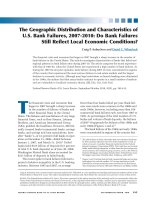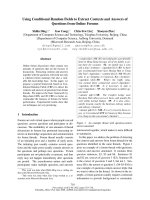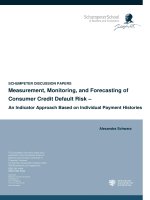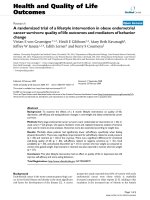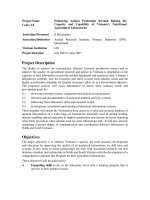antencedents and mediators of consumer’s online purchase intention
Bạn đang xem bản rút gọn của tài liệu. Xem và tải ngay bản đầy đủ của tài liệu tại đây (629.22 KB, 75 trang )
UNIVERSITY OF ECONOMICS HO CHI MINH CITY
International School of Business
------------------------------
Nguyen Thi Thanh Tuyen
ANTENCEDENTS AND MEDIATORS OF CONSUMER’S ONLINE PURCHASE
INTENTION
MASTER OF BUSINESS (Honours)
Ho Chi Minh City – Year 2015
UNIVERSITY OF ECONOMICS HO CHI MINH CITY
International School of Business
------------------------------
Nguyen Thi Thanh Tuyen
ANTENCEDENTS AND MEDIATORS OF CONSUMER’S ONLINE PURCHASE
INTENTION
ID: 22120036
SUPERVISOR: Nguyen Quynh Mai
Ho Chi Minh City – Year 2015
i
ANTENCEDENTS AND MEDIATORS OF CONSUMER’S ONLINE PURCHASE
INTENTION
Nguyen Thi Thanh Tuyen
UNIVERSITY OF ECONOMICS HO CHI MINH CITY
International School of Business
ii
ACKNOWLEDGEMENTS
I am deeply grateful to my advisors, Dr. Nguyen Quynh Mai for the guidance and comments
through the process of completing this thesis. Without the support and encouragement from Dr.
Nguyen Quynh Mai, the thesis might not be completed in meeting the requirements and
expectation of the research. I also want to say thanks to my classmates and others who
complete the surveys and share knowledge with me.
Nguyen Thi Thanh Tuyen
July 4th, 2015
iii
ABSTRACT
Many e-vendors have been investigated in Vietnam but not all of them are successful. In order
to be successes, e-vendors need to know how to attract consumers by understanding consumers’
purchase intention. In this study, five factors that were proposed to have influence on purchase
intention. Those were technology characteristics, trust, social influence, perceived ease of use,
perceived usefulness. A survey was launched in August, 2014 and 180 responses was collected
in Ho Chi Minh City, Vietnam for analyzing. The findings showed that perceived usefulness is
not a factor that influences purchase intention. Perceived ease of use is found to be a key factor
that influence purchase intention directly. Technology characteristics, trust, and social influence
are three factors that influence purchase intention indirectly via mediator perceived ease of use.
To gain consumers online purchase intention, e-vendors should provide products and services
that gain consumers’ perceived ease of use. Besides that, their websites need to be easy to read
and easy to understand by improving technology characteristics. E-vendors also need to gain
trust and social influence to increase consumers’ purchase intention. The results of this study
provide a valuable insight on the direct impact of perceived ease of use and the indirect impact
of trust, social influence, and technology characteristics towards online purchase intention.
iv
TABLE OF CONTENTS
ACKNOWLEDGEMENTS ..............................................................................................II
ABSTRACT .................................................................................................................... III
CHAPTER 1: INTRODUCTION ..................................................................................... 1
1.1. BACKGROUND ........................................................................................................ 1
1.2. PROBLEM STATEMENT ........................................................................................ 2
1.3. RESEARCH OBJECTIVES ...................................................................................... 4
1.4. RESEARCH QUESTIONS ........................................................................................ 4
1.5. RESEARCH SCOPE AND LEMITATION .............................................................. 4
1.6. THESIS STRUCTURE .............................................................................................. 4
CHAPTER 2: LITERATURE REVIEW .......................................................................... 5
2.1. CONCEPTS................................................................................................................ 5
2.1.1 E-Retailing................................................................................................................ 5
2.1.2 Online Purchase Intention ........................................................................................ 6
2.1.3 Consumer Behavior .................................................................................................. 6
2.2 THEORIES OF CONSUMER BEHAVIOR .............................................................. 7
2.2.1 Theory of Reason Action - TRA ............................................................................. 7
2.2.2 Theory of Planned Behavior – TPB ......................................................................... 8
2.2.3 Theory of Acceptance Model – TAM ...................................................................... 9
2.3 ATTENCEDENTS OF ONLINE PURCHASE INTENTION .. ...............................11
2.3.1 Perceived Usefulness... ...........................................................................................11
2.3.2 Perceived Ease of Use ... .........................................................................................13
2.3.3 Trust......... ...............................................................................................................14
2.3.4 Social Influence ...................................................................................................... 16
2.3.5 Technology Characteristics .... ................................................................................17
2.4 CONCEPTUAL MODEL .... .....................................................................................18
v
2.5 CHAPTER SUMMARY .... .......................................................................................19
CHAPTER 3: REASECH METHODOLOGY ... ............................................................20
3.1 RESEARCH PROCESS ... ........................................................................................20
3.2 MEASUREMENT SCALES... .................................................................................22
3.3 DATA COLLECTION METHOD... .........................................................................25
3.3.1 Sample and Sample Size .........................................................................................25
3.3.2 Data Collection Process......................................................................................... 25
3.4 DATA ANALYSIS METHOD ............................................................................ ... 25
3.4.1 Descriptive Analysis .......................................................................................... .. 26
3.4.2 Reliability Analysis ........................................................................................... ... 26
3.4.3 Exploratory Factor Analysis .............................................................................. .. 26
3.4.4 Multiple Regression Analysis............................................................................. .. 27
3.4.5 Testing Mediation with Regression Analysis......................................................... 28
3.5 CHAPTER SUMMARY....................................................................................... ... 28
CHAPTER 4: DATA ANALYSIS.............................................................................. .. 29
4.1 DESCRIPTIVE ANALYSIS.... ................................................................................ 29
4.1.1 Gender .... ................................................................................................................31
4.1.2 Age. .. ..................................................................................................................... 31
4.1.3 Education. ... ........................................................................................................... 31
4.1.4 Income ... ................................................................................................................ 31
4.1.5 Career .. .................................................................................................................. 32
4.1.6 Frequency of Online Purchasing ............................................................................32
4.1.7 Most Recent Purchase ... ........................................................................................ 32
4.2 RELIABILITY ANALYSIS .. .................................................................................. 32
4.3 EXPLORATORY FACTOR ANALYSIS ............................................................... 35
4.4 HYPOTHESES TESTING ....................................................................................... 39
vii
4.4.1 Assumption Test. ... .................................................................................................39
4.4.2 Testing Mediation with Regression Analysis ........................................................ 42
4.5 CHAPTER SUMMARY .......................................................................................... 49
CHAPTER 5: CONCLUSION AND IMPLICATION .................................................. 50
5.1 DISCUSSION .......................................................................................................... 50
5.2 MANAGERIAL IMPLICATIONS ......................................................................... 52
5.3 LIMITATION OF STUDY AND FUTURE RESEARCH ..................................... 53
5.4 CONCLUSION ......................................................................................................... 54
REFERENCES .... ........................................................................................................... 56
APPENDICES ............................................................................................................... 61
LIST OF FIGURES .......................................................................................................... 8
Figure 2.1: Theory of Reasoned Action model ................................................................ 8
Figure 2.2: Theory of Planned Behavior – TPB .............................................................. 9
Figure 2.3: Original TAM .............................................................................................. 10
Figure 2.4: Final version of TAM .................................................................................. 11
Figure 2.5: E-retailing purchase intention model ........................................................... 18
Figure 3.1: Research Process ......................................................................................... 21
Figure 4.1: Revised e-retailing purchase intention model ............................................ 38
Figure 4.2: Histogram ..................................................................................................... 40
Figure 4.3: P-P Plot ........................................................................................................ 41
Figure 4.4: Scatter Plot .................................................................................................. 41
Figure 4.5: Diagram of description step 1-3 ................................................................... 44
Figure 4.6: Diagram of description step 4 ....................................................................... 45
Figure 4.5: Model Tested Result ..................................................................................... 46
vii
LIST OF TABLES
Table 3.1: Results of the Reliability Test (Pilot)............................................................ 24
Table 4.1: Descriptive Analysis ..................................................................................... 29
Table 4.2: Results of Reliability Test .............................................................................. 33
Table 4.3: KMO and Bartlelt’s Test ................................................................................ 35
Table 4.4: Total Variance Explained............................................................................... 36
Table 4.5: Rotated Factor Matrix .................................................................................... 37
Table 4.6: Collinearity Statistics ..................................................................................... 39
Table 4.7: Coefficients of TC, T, and SI Predicting PI ................................................... 42
Table 4.8: Coefficients of TC, T, and SI Predicting TB ................................................. 43
Table 4.9: Coefficients of TB Predicting PI .................................................................... 43
Table 4.10: Coefficients of TC, T, SI, and TB Predicting PI .......................................... 44
Table 4.11: Testing with Regression Analysis Result .................................................... 48
1
CHAPTER 1
INTRODUCTION
1.1.
Background
Internet has been very popular for a networking media. It also created a new form of retail
which is known as e-retailing or web shopping. It is a necessary medium for global market
transaction. Developing of e-retailing allows shoppers to purchase products or services from
the web-retailers and search products information over the Internet. E-retailers don’t have to
spend money for space (Keeney, 1999; Turban and King, 2003). Consumers can buy products
on e-retailing websites by making transaction via virtual interface. It’s more convenient than
traditional shopping which usually causes anxious crowded, traffic jam, limited time, and
parking space. However, web shopping is perceived to be more risky than traditional way, so
trust play a crucial role for consumers making online transaction (Pavlou, 2003).
E-retailing has arisen in Vietnam from 2001. Together with the event joining WTO in
2006, Vietnam becomes a promising environment for e-retailing in next five years. A recent
study Irwin and Nguyen (2013) showed that Vietnam’s e-retailing market value achieved
approximately $300 million in 2011 and is expected to gain $2.8 billion by 2015 with growth
rate at 75% from 2011 to 2015 (Irwin and Nguyen, 2013).
In 2013, German Rocket Internet invested $250 million in Lazada Group, an online eretailing group, to five countries in Southeast Asia including Vietnam. Observers commented
that it is the right time for foreign investors to gear up their investment plans in Vietnam. Many
market reports have predicted that an online boom will happen in near future. Tran
TrongTuyen, the director of DKT, forecasted that the Vietnamese e-commerce market in 20142015 will be doubled that of 2013. In 2013, Epinion, a market survey firm reported that 50% of
Vietnamese internet users use online shopping. Lazada’s CEO, Alexandre Dardy, believes that
shopping online through smartphones will be the tendency in near furure which will be favored
by young consumers. Vietnam Net Bridge, a market survey firm, has reported that Vietnam
2
ranks second in the world in using smartphone. It is the reason for traditional retailers such as
FPT Shop, Nguyen Kim, and The Gioi Di Dong last year began to expand their investments to
develop online retailing (VietNamNet Bridge).
In order to be successful, e-retailers need to learn about Vietnamese consumer’s
characteristics to understand consumers’ purchase intention. Purchase intention refers to
willingness of consumers when buying products and services online (Kimery and McCord,
2002). The purchase intention is the key element that leads to make the final decision on
buying products. Purchase intention is evaluated base on the consumers’ willingness to
purchase and their willingness to purchase again within a period of time. Furthermore, prior
studies have showed that purchase intention is a key factor that influences consumers’ buying
behavior and their shopping activities in the future (Pi et al., 2011; Pavlou and Gefen, 2004).
Different from consumers in developed countries, people search products, play orders,
and make payment online, Vietnamese often search on the internet and place order online but
making payment by cash in person. Nguyen Ngoc Dung, chief representative of VECOM’s
HCM City Branch, the Vietnam e-commerce association, pointed out that shopping online
barrier does not lie in technology solutions but in consumer’s habits (VietNamNet Bridge,
2014). Vietnamese wants to see products in person before buying, so Vietnamese want to make
payment after delivery of goods. E-retailing firms now have to accept that. It’s caused a lot of
pain for e-retailing firms when many orders are cancelled upon delivery and the companies
have to incur the cost of delivery. This problems need to be solved for e-retailing firms don’t
have to bear the pain of canceled order upon delivery.
1.2.
Problem Statement
Vietnamese doesn’t believe in the quality of products until they physically touch them, so they
prefer to buy products in store after reviewing on the web. It’s critical for companies to win
Vietnamese consumers’ trust to against skepticism. While online payment via the bank is a
mainly method in developed countries, the kind of method is not widely used in Vietnam.
Online shoppers still pay in cash upon delivery. Payments via bank accounts and intermediate
3
payments are accounted for 41% to 8% respectively (Vecita, 2014). It’s because some people
don’t have bank account and the others don’t trust banking system. This issue is a great pain for
companies since some people cancel order on delivery. If people trust banking system and
product qualities, then they will think making payment online is useful and their perceived
usefulness will influence their purchase intention. If social influence such as social media,
friends, relative, colleagues, etc. pays online for their shopping cart, then people will think
payment online is useful and their perceived usefulness will influence their purchase intention.
TAM model has been applied in many technology fields and e-retailing field is not
exceptional. In 1996, Venkatesh and Davis introduced final version of TAM model. When
investigating information system using behavioral, they recognized that perceived usefulness
and perceived ease of use influence behavioral intention directly. Following pervious studies
such as Ramayah and Ignatius (2005), Koufaris (2002), Garwal and Prasad (1999), Chau and
Hu (2001), Moon and Kim (2001), Ngo (2013), Ho and Chen (2013), Jun et al. (2004), and
Honarbakhsh et al. (2013), this study will also use TAM as a main theory to develop research
framework. In this study, perceived ease of use and perceived usefulness are two keys factors
that influence purchase intention directly. External factors that influence purchase intention
indirectly via those two key factors that are technology characteristics, social influence, and
trust.
Trust and social influence are another problem that influence consumers on perceived
usefulness which influence purchase intention according to TAM Model. Besides that,
technology characteristics are the problem that influence purchase intention via perceived ease
of use. Overall, trust, social influence, technology characteristics, perceived ease of use,
perceived usefulness are all problems that preventing consumers from online purchasing.
There are many e-retailing studies have been done in Vietnam but e-vendors still have to
deal with online transaction problem. Most consumers still use cash payment upon delivery
which cause a lot of pain for e-vendor when orders are canceled upon delivery. This study will
investigate indepth about consumers’ purchase intention to help e-vendors solve the problem.
4
1.3.
Research Objectives
This study aims to apply TAM model to identify if perceived usefulness, perceived ease of use,
trust, social influence, and technology characteristics influence consumers’ online purchase
intention.
1.4.
Research Questions
The research is to answer the following question
How do perceived usefulness, perceived ease of use, trust, social influence, and
technology characteristics influence purchase intention?
1.5.
Research Scope and Limitation
Research scope: the research takes place in HCMC and data is collected from August 12th,
2014 until September 12th, 2014.
Limitation: Most of people I know work in high tech industries, so they are more
familiar with internet than the others. Ho Chi Minh City is the biggest city, people live in
HCMC will shop online more than people from other cities. Therefore, the result may
overestimate Vietnamese consumers purchase intention.
1.6.
Thesis Structure
This thesis have five chapter. The first chapter is introduction which introduces about research
background, research problems, research questions, research objectives, research scope and
limitation, and thesis structure. The second chapter does the literature review, proposed
hypothesis, and then proposed research model. The third chapter introduces about methodology
to be conducted. The chapter fourth represents research results. After having the result, chapter
five makes conclusion and gives recommendation.
5
CHAPTER 2
LITERATURE REVIEW
This chapter will review previous studies to understand main concepts of this studies and
identify key factors that influence online purchase intention. Hypotheses are proposed after
reviewing key concepts and theories foundation.
2.1.
Concepts
2.1.1 E-retailing
According to Awais and Samin (2012), e-retailing has looping process. In looping process, a
company or a consumer uses internet to browse products that his/her want and compare with
others products to see its advantages. When he/she completely satisfies with the products,
he/she will place an order. The order will then be in the virtual shopping cart for online
transaction option. When he/she completes payment, the seller will notify his/her about the
fulfillment of the order. The order will be soon shipped and delivered to the consumers. If the
consumers are satisfy with the services, then they will repurchase from that e-retailer.
Awais and Samin (2012) pointed out the strength, weakness, opportunity, and threat of
e-retailing. The major strengths of e-retailing are no boundary, no physical company setup,
time saving. The major weaknesses are security, fraud, fake websites, and long delivery timing.
Changing trends, new technologies, and global expansion are considered as opportunities for eretailing to be grown. Privacy concern, risk, and fraud are thread for e-retailing.
Popularity of internet connectivity together with developing new powerful tools for
using internet related devices have created a new era of retail which is called e-retailing. Eretailing is a type of business that operates by selling and buying of goods and services through
computer by using internet. The developing of e-retailing has led businesses to online market.
E-retailing gives opportunities for sellers and potential buyers to interact with each other
6
fromdistance by just one click. Saving time and money are a key success for e-retailing (Awais
and Samin, 2012).
2.1.2 Online Purchase Intention
Customer purchase intention is considered as an important signal to determine the strength of a
consumer’s intention to carry out a specified purchasing behavior via Internet in the online
shopping environment (Salisbury, et. al., 2001). Furthermore, the theory of reasoned action
(TRA) also proposed that consumer behavior can be predicted from intention. Intention
influences consumer behavior in terms of action, target, and context (Ajzen and Fishbein,
1980). According to Day (1969), consumer intention can be measured more effective than
consumer behavior because consumer may make a purchase due to constraints rather than real
preference when purchase is considered.
Purchase intention is one of the components of consumer behavior on how individuals
want to purchase a specific brand. Laroche, Kim, and Zhou (1996) suggested that purchase
intention can be measured by variables which influence consideration or expectation in buying
a specific brand. According to Pavlou (2003), he defined online purchase intention as a
situation when consumers are willing and intend to involve in an online transaction. The online
transaction is defined as an activity in which information retrieval, information transfer, and
product purchase are processed (Pavlou, 2003). Information retrieval and information transfer
are considered as intentions to use a website. When consumers use a website and want to buy
products, then the online transactions occur (Pavlou, 2003). Therefore, it’s very important to
study consumer purchase intention to encourage individuals make purchase on web shopping
environment.
2.1.3 Consumer Behavior
Consumer behavior is influenced by external and internal factors. External factors are
considered as the environmental condition, and internal factors are related to the consumer’s
mind (Mitta, 2013). Consumer behavior of every individual is different from another because
7
of buying habits and choices which are influenced by psychological and social drivers
(Brassington and Pettitt, 2000). People often change their mind but they usually don’t realize
that. Most people after changinh their mind and reconstructing their past opinion, they believe
that they always thought like that (Keys, 2011). So consumer behavior is difficult to predict.
Mitta (2013) suggested that the external factors have five sectors which are demographics,
socio-economoics, technology and public policy, culture, and sub-culture. He also suggested
that internal factors are influenced by variety of psychological processes which is attitudes,
learning, perception, motivation, self-image, and semiotics.
In addition, Seth (1983) also proposed that the consumer’s behavior has two type of
motives while shopping. They are functional and non-functional. The functional motives are
time, shopping place, and consumer’s needs. The consumers will be motivated if they can save
time when shopping in an environment where they don’t have to pay parking fee and lower
cost with widely range of products to choose. The non-functional behavior motives are related
to culture or social values such as the brand name of the store.
2.2.
Theories of Consumer Behavior
TAM is the Theory of Technology Acceptance model that has been used for many prior studies
in e-retailing field, so this study will use TAM as a main theory to develop the research model.
TAM was develop based on TRA, Theory of Reason Action, byAjzen and Fishbein (1980) and
TPB, Theory of Planned Behavior by Ajzen (1985), so TRA, TPB will also be introduced to for
reader to understand how TAM to be developed.
2.2.1 Theory of Reason Action – TRA
Theory of Reasoned Action (TRA) was proposed Ajzen and Fishbein(1980). They suggested
that a person actual behavior is influenced by their prior behavioral intention along with beliefs
that the person would have for the given behavior. They also proposed that behavioral intention
is determined by a person attitude towards the actual behavior and the subjective norm
8
associated with the behavior. The person attitude is defined as a person’s positive or negative
feelings about performing actual behavior. The attitude of a person can be measured by the sum
of the product of all salient beliefs about consequences of performing that behavior and the
evaluation of those sequences. The subjective norm is the person’s perception that most people
who are important to him or her think he or she should or should not perform the behavior. The
subjective norm is the sum of product of person’s normative beliefs and his or her motivation
to comply. The normative beliefs are perceived expectations of other individuals or groups.
Thus, Theory of Reasoned Action is an appropriate model for explaining and predicting
personal behavioral intention or consumers’ purchase intentions.
Belief and
Evaluations
Attitude
toward
Behaviors (A)
Behavioral
Actual
Intention
Behavior
(BI)
Normative beliefs and
Motivation to comply
Subjective
Norm
(SN)
Figure 2.1: Theory of Reasoned Action model (Davis, Bagozzi, and Warshaw, 1989)
2.2.2 Theory of Planned Behavior – TPB
The Theory of Planned Behavior (TPB) was proposed by Ajzen (1985). TPB is very similar to
the TRA, except that it takes into account the perceived behavioral control (PBC). PBC is the
perception of control over performance of a given behavior. PBC is determined by two beliefs
which are control beliefs and perceived facilitation. Control beliefs include perceived
availability of skills, resources, and opportunities. Perceived facilitation belief is the
individual’s assessment of available resources to the achievement of a given set of outcomes.
The perceived behavioral control construct could help identify specific barriers to system use
such as limitations in users kills.
9
Behavioral beliefs
and
Outcome
Evaluations
Attitude
Behavioral beliefs
and
Outcome
Subjective
Norms
Behavioral beliefs
and
Outcome
Perceived
Behavioral
Control
Intention
Behavior
Figure 2.2 Theory of Planned Behavior – TPB (Ajzen, 1985)
2.2.3 Theory of Technology Acceptance Model – TAM
Fred Davis proposed the Technology Acceptance Model (TAM) in 1985 when he worked on
his doctoral thesis at the MIT Sloan School of Management. He suggested that actual system
use is directly influenced by user’s motivation to use the system. The user’s motivation
depends on system features and capabilities (Davis, 1985).
Relying on TRA (Fishbein and Ajzen, 1975), Davis further refined his conceptual
framework to propose the theory of Technology Acceptance Model (TAM). In this model,
Davis suggested that users’ motivation is influenced by perceived ease of use, perceived
usefulness, and attitude toward using the system. A person’s attitude toward using the system
was considered to be the major determinant of the person actually using the system. The
attitude was then influence by perceived ease of use, and perceived usefulness. Davis adapted
TRA to develop his model and made two main changes. Firstly, he did not take subjective
norm into account in predicting the actual behavior of a person. Secondly, he only defined two
10
beliefs which are perceived usefulness and perceived ease of use, instead of several individual
salient beliefs to determine the attitude towards a given behavior. Davis defined perceived
usefulness as individual perspective about using a particular system would enhance his or her
job performance. Perceived ease of use was defined as individual perspective about using a
particular system would be free of physical and mental effort. He thinks those two beliefs was
enough for predicting individual attitude toward the use of a system. Both of these beliefs were
influenced by system design characteristics which are X1, X2, and X3 in the figure below.
User Motivation
Perceived
X1
Usefulness
X2
X3
Attitude
Actual
Toward Using
System Use
Perceived
Ease of Use
Figure 2.3: Original TAM proposed by Fred Davis(Davis,1985,p.24).
Davis, Bagozzi, and Warshaw (1989) tested the model above and they recognized that
perceived usefulness had great influence on people’s intention and perceived ease of use had a
small but significant influence on people’s intention. The most important finding is that both
perceived usefulness and perceived ease of use influenced behavioral intention directly. Thus
the final version of TAM model eliminated the need for the attitude construct from the model.
11
Perceived
Usefulness
External
Variables
Behavioral
Intention
Actual
System
Use
Perceived
Ease of Use
Figure 2.4: Final version of TAM(Venkatesh&Davis,1996,p.453)
2.3.
Antecedents of Online Purchase Intention
Based on TRA, TPB, TAM, and prior studies, this study propose that perceived usefulness and
perceived ease of use influence purchase intention directly. Social influence and trust influence
purchase intention indirectly via mediator perceived usefulness. Technology characteristics
influence purchase intention indirectly via mediator perceived ease of use. Following section
will discuss about why those factors should be chosen to be the main antecedents of online
purchase intention.
2.3.1 Perceived Usefulness
Perceived usefulness refers to the individual’s beliefs about the usefulness of purchasing on
retail websites (Guritno and Siringiringo, 2013). They also proved that perceived usefulness
has a direct influence on intention to use Internet and it has stronger effect on shopping
intention than perceived ease of use. Perceived usefulness is the degree to which a person
believes that using internet system will enhance his/her purchasing performance. In case of eretailing, perceived usefulness is a consumer’s subjective probability thinking that Internet
usage will efficiently smoothen the progress of purchase (Koufaris and Sosa, 2004). Potential
consumers would want to engage in retail websites which are practical and capable to enhance
their purchasing performance in searching desired products or services (Chui et al., 2005). The
12
potential consumer can like or dislike engaging in online purchasing based on whether the
tradeoff is beneficial to the potential consumer as opposed to other types of retailing (Ramayah
and Ignatius, 2005). Ramayah and Ignatius (2005) believes that usefulness will attract online
consumers. The belief is in line with Davis (1989) who defines perceived usefulness as
consumers’ perspective about increasing their performance. In e-retailing context, the
performance would be the benefits of purchasing a product through a retailing website minus
the tradeoff of a physical retailing. In the past, Koufaris (2002) also have validated that
perceived usefulness influence the intention of potential online consumers directly.
Additionally, Agarwal and Prasad (1999), Chau and Hu (2001), Moon and Kim (2001) also
proved that perceived usefulness influence behavioral intention positively and significantly.
In Vietnamese e-retailing market, it indicates that perceived usefulness has strong
impact on purchase intension (Ngo, 2013; Ho and Chen, 2013). Ngo (2013) prove that
perceived usefulness influences purchase intention directly studying about factors influencing
consumer online purchase intention of fashion in Vietnam – the case of Zalora. In another
study, Ho and Chen (2014) proved that technology beliefs, which are represented by perceived
usefulness affect purchase intention indirectly through technology attitudes when studied about
Vietnamese consumers’ intention to use online shopping. Their research result shows that
perceived usefulness is the strongest predictor for Vietnamese consumers’ intention to shop
online. Ho and Chen (2014) believes that Vietnamese consumers’ intention to adopt online
shopping as a shopping medium is firstly explained by perceived usefulness of their own using.
In another word, the higher consumer’s perceived usefulness of online shopping is, the stronger
their technology attitudes are, then they become ready to adopt online shopping as a shopping
medium. In the first phase of being contact with online shopping, shoppers prefer to something
new. If they see immediate benefits of this shopping channel, they will accept it as a shopping
channel.
Following previous studies, it’s reasonable to propose that:
13
H1: Perceived usefulness has a positive relationship with consumers’ online purchase
intention
2.3.2 Perceived Ease of Use
According to Davis (1989), perceived ease of use refers as the degree to which and individual
believes that using a particular system would be free of effort. He stated definition about
perceived ease of use in broad context which can be understood in any fields. Chiu et al. (2005)
provided specific definition in e-retailing field as the degree of how consumers believe that
retail websites can help them to search information with less effort. Thus, purchasing goods via
internet should not take much effort. The process of purchasing should be done by just a click
for online shoppers to engage in online shopping. In the e-retailing context, the dimensions
ease of use refers to the ease of ordering, functionality, navigation of website, and accessibility
of information (Reibstein, 2002). Consumers will prefer to visit a website with good quality
web design rather than a complicated and ambiguous websites. A good quality web design will
increase customer satisfaction which leads to a higher online purchase intention (Lee & Lin,
2005). On the other hand, if users perceive that a website is difficult to use or complicated and
ambiguous, they will show a lower intention on purchasing (Green, Pearson, & Pearson, 2007).
Poorly designed forms would cause consumers to lose focus on their shopping carts. In another
words, it will reduce perception on the ease of use of online shopping and the consumers will
develop a negative attitude. In turn, it will make potential consumers do not want to engage in
internet shopping (Ramayah and Ignatius, 2005).
Conventional shopping usually causes anxious, crowded, traffic jam, limited time, and
parking space (Yulihasri, Islam, and Daud, 2011). Purchasing via retail websites is surmised to
have beneficial outcomes, but the hassle of engaging in the interaction medium lead to daunt
for some consumers (Ramayah and Ignatius, 2005). If the hassle is outweigh the benefit of
purchasing online, then the consumers will prefer to purchase in conventional way. If a website
has a well-designed user interface, consumers are likely to believe that online shopping is easy.
14
According to Jun et al. (2004) and Honarbakhsh et al. (2013), perceived ease of use influences
the consumers’ purchase intention in e-retailing context.
E-retailing purchase intention has been studied in Vietnam. Ho and Chen (2013), Ngo
(2013) explore that perceived ease of use has great influence on purchase intention. Ngo (2013)
studies about factors influencing consumer online purchase intention of fashion in Vietnam –
the case of Zalora and found out that perceived ease of use is the strongest factors influence
purchase intention directly among product and company attributes, and perceived usefulness
factors. Ho and Chen (2013) considers perceived ease of use as a component of technology
belief which influence purchase intention indirectly via mediator technology attributes. They
believe that once online buyers have good understanding and knowledge about Internet, they
will be more actively applying such knowledge to their online shopping. Generally, with a
simple performance and implementation without any obstacles, consumers will have a positive
attitude towards online shopping. Then, they will be confidence to use that technology to make
online transaction. After reviewing international research and Vietnamese e-retailing studies,
it’s reasonable to propose that:
H2: Perceived ease of use has a positive relationship with consumers’ online purchase
intention
2.3.3 Trust
Trust is considered as a set of specific beliefs about the benevolence, competence, and integrity
of another party. Benevolence is the belief that the trustee will not act against the trustor even
in case of given the opportunity. Competence is the belief in the trustee’s ability to fulfill the
obligations as the trustor expected. Integrity is the belief that the trustee will be honest and will
honor its commitments (Mcknight et al. 2002). In additional, Gefen (2003) proposed that trust
refers to an expectation that trustee will not behave opportunistically and/or will take advantage
of trustor in any situation. If an e-retailing vendor can’t be trusted in accordance with the
consumers’ expectation, then there is no reason for consumers should expect to gain any
15
benefit from that vendor (Pavlou, 2003; Gefen, 2004; Chiu, 2009). According to Hoffman et al.
(1999), a lack of trust will prevent buyers from engaging in e-retailing because they are
implausible to transact with a vendor who fails to convey a sense of credibility. It’s mainly
because of fears of seller opportunism. If consumers initially trust an e-vendor and observe that
adopting online shopping is beneficial to shopping effective and performance, then they come
to believe that online shopping is useful for them (Gefen et al., 2003). Indeed, many previous
researches shows that trust play a crucial role in driving perceived usefulness (Gefen et al.,
2003; Pavlou, 2003).
Ho and Chen (2013) point out that consumers’ trust in online shopping plays a critical
role and prerequisite influencing on consumers’ intention to participate in online shopping
when studying about Vietnamese consumer’s intention to online shopping adoption. The
research result shows that the higher the reputation, the higher gain in case of favorable
behavior and the more certain online consumers about the e-vendor will not act
opportunistically. Especially, when consumers do not have personal experience with an evendor, the word of mouth about the reputation of a merchant is a key to attract them to make
transaction with that business. The shared information from ones who interact with the online
providers positively can help in reducing perception of risk and security issue of online buyers
when they make transactions with those providers. The reputation of online provider is the
basis to form the initial trust of an e-commerce purchase. Moreover, when buyers actually have
experience in online shopping, their faith will be created base on their experience or their
familiarity with the purchased goods. The experience and familiarity are two factors that help
buyers to reduce the uncertainty in transactions. When making online transaction, usually the
buyers cannot sure if the transaction can be risky and it is possible for damages to be recovered.
Hence, while making online transaction with e-vendors, the buyers are interested in ones who
are competence, benevolence, and integrity. Lee and Ngoc (2010) also find out that trust exerts
significant influence on online shopping behaviorand online shopping intention
16
wheninvestigating about the online shopping intention of Vietnamese students. Following
previous studies, it’s reasonable to propose that:
H3: Trust has a positive relationship with perceived usefulness
2.3.4 Social Influence
The circle of individual social life comprises his or her peers who are siblings, friends and
acquaintances (Pilgrim, 2001). The concept of reference groups is very important in
understanding consumer purchasing behavior as an individual adapts his/her habits according
to his/her belonging groups. He/she complies intentionally or unintentionally with the dominant
traits of the peers and forms his/her own traits (Clasen and Brown, 1985). According to
Ventakesh and Davis (2000), consumers usually take their family or peer’s opinion with initial
experience to evaluate information to judge online shopping sites. An individual is more like to
make online purchase more if his/her social groups desire to do online shopping.
Besides social groups, social media also contribute a strong impact on consumers online
purchasing through attractive advertisements and social networking sites. Social networking
sites provide a platform for people to connect with friends, family, and acquaintances. On
social networking sites, individual can conduct online social networking activities and send
products’ recommendation to their social network groups. It also allows retailers to leverage
consumers’ connections for commerce purposes, advertise, and promote their brands/products.
E-retailing can also manage interaction with consumers directly in an open environment and
sharing economy (Ng, 2012). This kind of social networking can understand as social influence
in this study.
Social recommendation gives advises for individual, so it makes social commerce to be
a trusted environment of which prospective consumers make buying decision based on the
advice of a network friends and family (Lietsala&Sirkkumen, 2008). Peers’ opinions make
significant impact on technology usefulness as Lin et al. (2003) studied about digital
government system. The result of their study proved that social influence affect perceived
usefulness directly on technology acceptance.
